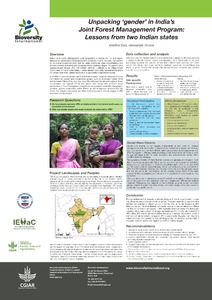Unpacking 'gender' in India's Joint Forest Management Program: lessons from two Indian states
Abstract
India’s Joint Forest Management (JFM) programme is among the first and largest initiatives for collaborative forest governance worldwide. In JFM, the state, represented by the Forest Department (FD), and the village community share responsibilities and benefits of jointly protecting and managing forests adjoining villages. The agreement is operationalized through JFM Committees (JFMCs) – referred to as Village Forest Committees (VFCs) in some states – where elected community representatives and a FD official make forest-related decisions in a supposedly collaborative manner. In an effort to promote gender equity and social inclusion, seats are reserved on these committees for women and marginalized groups, such as Scheduled Castes (SCs) and Schedule Tribes (STs). Yet, despite reservations, the ability of these groups to actively engage in JFM processes remains limited.
This study addresses two primary questions: 1) Do local people perceive JFM, as implemented in two Indian landscapes, as equitable and inclusive?; 2) How can gender equity and social inclusion be improved in India’s JFM Program? Our research shows continued social exclusions from JFM processes on the basis of gender and ethnicity. Gender and ethnicity do not operate independently of each other to influence active participation in JFM. Participation is shaped at the intersection of gender and ethnicity, such that women and men from different ethnic groups have distinct experiences with JFM. Our findings underscore the need to reframe the issue of ‘women’s participation’ to capture inequalities among women from different ethnic groups. We conclude with recommendations for enhancing gender equality and social inclusion in JFM.

